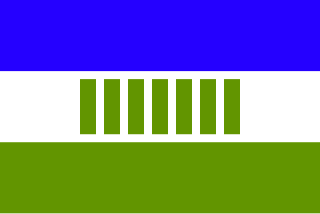The history of Namibia has passed through several distinct stages from being colonised in the late nineteenth century to Namibia's independence on 21 March 1990.

A Bantustan was a territory that the National Party administration of South Africa set aside for black inhabitants of South Africa and South West Africa, as part of its policy of apartheid. By extension, outside South Africa the term refers to regions that lack any real legitimacy, consisting often of several unconnected enclaves, or which have emerged from national or international gerrymandering.

Khoekhoen are the traditionally nomadic pastoralist indigenous population of southwestern Africa. They are often grouped with the hunter-gatherer San peoples. The designation "Khoekhoe" is actually a kare or praise address, not an ethnic endonym, but it has been used in the literature as an ethnic term for Khoe-speaking peoples of Southern Africa, particularly pastoralist groups, such as the !Ora, !Gona, Nama, Xiri and ǂNūkhoe nations.
The Griquas are a subgroup of heterogeneous former Khoe-speaking nations in Southern Africa with a unique origin in the early history of the Cape Colony. Under apartheid, they were given a special racial classification under the broader category of "Coloured".

The Basters are a Southern African ethnic group descended from white European men and black African women, usually of Khoisan origin, but occasionally also enslaved women from the Cape, who resided in the Dutch Cape Colony in the 18th century. Since the second half of the 19th century, the Rehoboth Baster community has been concentrated in central Namibia, in and around the town of Rehoboth. Basters are closely related to Afrikaners, Cape Coloured and Griqua peoples of South Africa, with whom they share a language and culture.

Rehoboth is a town in central Namibia just north of the Tropic of Capricorn. Located 90 kilometres south of the Namibian capital Windhoek, Rehoboth lies on a high elevation plateau with several natural hot-water springs. It receives sparse mean annual rainfall of 240 millimetres (9.4 in), although in the 2010/2011 rainy season a record 731 millimetres (28.8 in) were measured. In 2005, it had a population of 21,378 later increased to 28,843 in 2011, according to the 2011 Namibian Population and Housing Census.

Ovamboland, also referred to as Owamboland, was a Bantustan in South West Africa, intended by the apartheid government to be a self-governing homeland for the Ovambo people.

Rehoboth was a bantustan in South West Africa intended by the apartheid government to be a self-governing homeland for the Baster people in the area around the town of Rehoboth, Namibia. A centrally administered local government was created in 1979. The bantustan existed until 29 July 1989, a few months prior to the Independence of Namibia.

The Turnhalle Constitutional Conference was a conference held in Windhoek between 1975 and 1977, tasked with the development of a constitution for a self-governed Namibia under South African control. Sponsored by the South African government, the Turnhalle Conference laid the framework for the government of South West Africa from 1977 to independence in 1989.
Johannes Gerard Adolph Diergaardt, more commonly known as Hans Diergaardt was a Namibian politician active for nearly a decade after Namibia gained independence. Prior to that, he was elected as the fifth Kaptein of the then-autonomous Baster community at Rehoboth, succeeding Dr. Ben Africa in 1979 after winning a court challenge to the disputed election of 1976.
The Federal Convention of Namibia (FCN) was a political party based in Rehoboth, Namibia. It was created in the wake of Namibian independence in 1988 by a merger of several smaller parties and gained a seat in the Namibian Constituent Assembly. After also-ran results in 1994 and 1999 it ceased to be publicly active.

Hermanus van Wyk (1835–1905) was the first Kaptein of the Baster community at Rehoboth in South-West Africa, today Namibia. Under his leadership, the mixed-race Basters moved from the Northern Cape to leave white racial discrimination, and migrated into the interior of what is now central Namibia; the first 30 families settled about 1870. They acquired land from local natives and were joined by additional Baster families over the following years. The Baster people developed their own constitution, called the Paternal Laws. They relied on the herding of sheep, goats and cattle as the basis of their economy.
Ben Africa is a Namibian politician, medical doctor, and former Baster captain.
John McNab was a Namibian politician who served as Rehoboth Baster captain from 1999 until 2020.
The Baster Council, is the parliament of the unrecognized state of the Rehoboth area in Namibia. It forms the legislature, or Volksraad, of Rehoboth together with the executive Captains Council (Kapteinsraad).

The Captainsof the Rehoboth Baster were the traditional leaders of the indigenous Baster community in central Namibia, until the dissolution of the Rehoboth Homeland in 1990, upon Namibian independence.
Cornelius van Wyk was the second Captain of the Rehoboth Baster, serving from 1914 until his death in 1924.
Albert Mouton was the third Captain of the Rehoboth Baster in South West Africa from 1924 to 1925.
The Rehoboth Uprising of 1924-25 was the bloodless revolt of the Rehoboth Baster against the South African Administration in South West Africa. The revolt was caused by diminishing Baster autonomy and territory, as a result of Administration policies.








